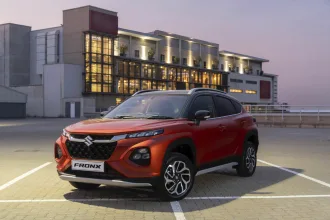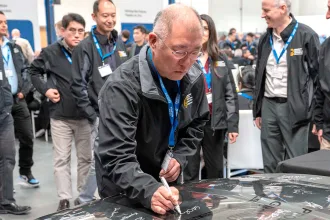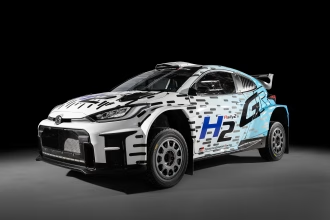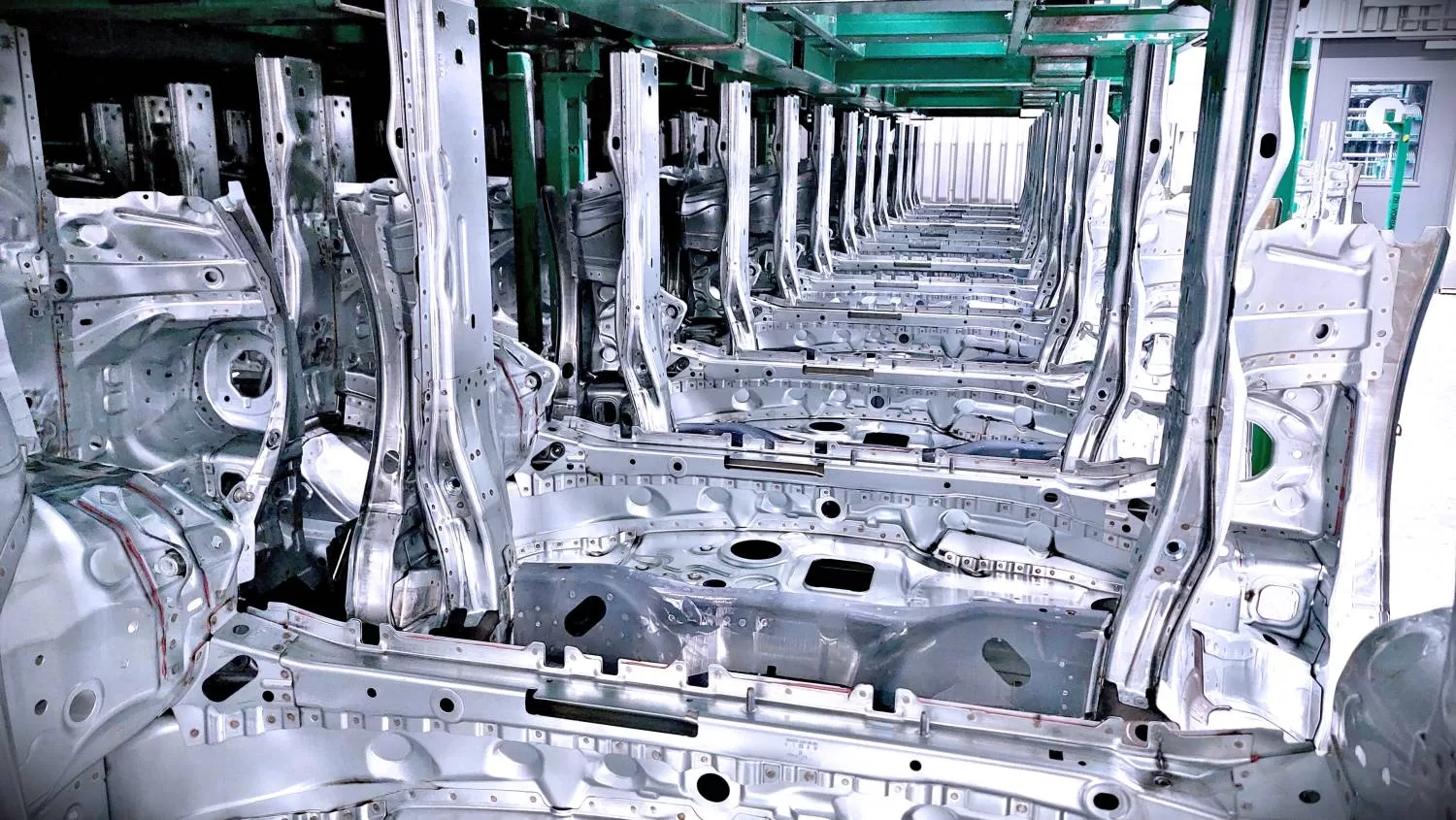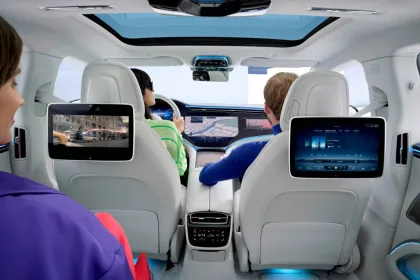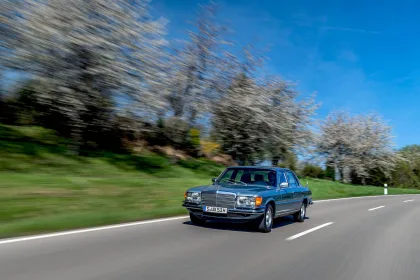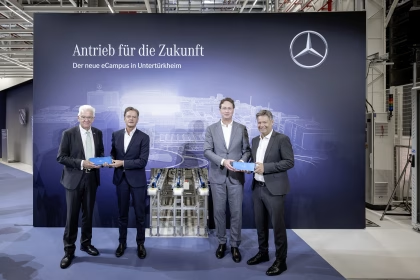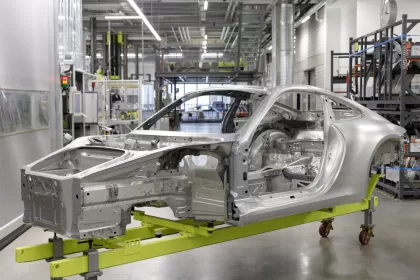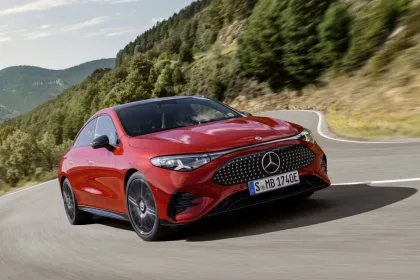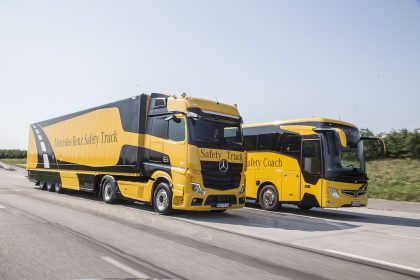- Next milestone of “Ambition 2039”: Mercedes-Benz aims to use more than 200,000 tonnes of CO₂-reduced steel in its press shops annually, procured from its European suppliers Salzgitter, thyssenkrupp Steel, voestalpine, Arvedi as well as SSAB and H2 Green Steel
- Another step towards a circular economy: voestalpine recycles steel scrap from Mercedes-Benz
- Almost CO₂-free steel arrives at production plant: Mercedes-Benz first passenger car manufacturer to have used steel from SSAB’s hydrogen-based direct reduction process in its prototypes
Mercedes-Benz follows a clear goal in its climate protection activities: To prioritise cutting and avoiding any CO₂ emissions before off-setting them. Within this decade, Mercedes-Benz is aiming to use more than 200,000 tons of CO₂-reduced steel from European suppliers in its press shops annually. The roll-out of a sustainable steel supply chain in Europe will serve as a blueprint for other regions. Steel accounts for up to 20% of the total CO₂ emissions in the production of an electric vehicle. With the supply agreements, Mercedes-Benz achieved another milestone towards its ambitious climate protection goal “Ambition 2039”: By 2030 at the latest, Mercedes-Benz Cars aims to at least halve the average CO₂ emissions per passenger car in the new vehicle fleet compared to 2020, across the entire life cycle from raw material procurement to use and recycling.
“The more than 200,000 tonnes of CO₂–reduced steel per annum for the supply of our production facilities in Europe mark a considerable milestone for our ambitious sustainability goals. Together with its partners, Mercedes-Benz will continue to pave the way towards a net carbon-neutral new car fleet by 2039. At the same time, we are sending an important signal for the transformation of the European steel industry.”
Markus Schäfer, Member of the Board of Management of Mercedes-Benz Group AG, Chief Technology Officer, responsible for Development and Procurement
Steel production in transition
In conventional primary steel production, which uses blast furnaces and basic oxygen furnaces, the production of one tonne of steel generates more than two tonnes of CO₂ on average. If a direct reduction process is combined with the steel making in an electric arc furnace (EAF), rather than coke-based blast furnace production, CO₂ emissions can be significantly reduced. In a natural-gas-based direct reduction process, carbon monoxide and hydrogen dissolve the oxygen from the iron ore. In the electric arc furnace, the direct-reduced iron is melted directly into steel together with steel scrap. If green hydrogen and renewable energies are used instead of natural gas to operate the electric arc furnace during direct reduction emissions can be reduced even further, resulting in almost CO₂-free steel.
“To make the automotive industry more sustainable, Mercedes-Benz and its partners are working to decarbonise the steel supply chain. The increased availability of green steel enables us to gradually introduce CO₂ reduced steel and in a second step to use almost CO₂ free steel in our vehicles, significantly helping to lower our carbon footprint.”
Dr. Gunnar Güthenke, Head of Procurement & Supplier Quality Mercedes-Benz Cars
Mercedes-Benz and thyssenkrupp Steel are jointly reducing the CO₂ footprint in the steel supply chain
Mercedes-Benz and thyssenkrupp Steel have signed a letter of intent for the procurement of CO₂-reduced steel. The two companies have agreed that the entire production process for CO₂-reduced steel products to be almost CO₂-free in future, using direct reduction plants in conjunction with innovative smelters – subject to the availability of green hydrogen. Thyssenkrupp plans to commission the first direct reduction plant in 2026 and then subsequently supply Mercedes-Benz.
CO₂-reduced steel from Salzgitter Flachstahl GmbH and Arvedi
Mercedes-Benz already sources CO₂-reduced flat steel from Salzgitter Flachstahl GmbH. This is produced solely from scrap in an electric arc furnace. As a result, CO2 emissions for the respective steel grades can be reduced by more than 60% compared to the conventional blast furnace route. In a letter of intent, Mercedes-Benz and Salzgitter have also agreed on sourcing raw steel produced with green electricity, which further increases the savings potential to more than 75%. From 2026, Salzgitter Flachstahl also plans to supply Mercedes-Benz plants with CO₂-reduced steel produced using a combination of direct reduction processes and electric arc furnaces as part of their SALCOS® – Salzgitter Low CO₂ Steelmaking Program.
Mercedes-Benz also sources CO₂-reduced steel from its Italian steel partner Arvedi. To this end, Arvedi has switched part of its production to green electricity. The partners aim to successively increase the supply volumes of CO₂-reduced steel.
Return of manufacturing scrap to voestalpine in Linz
In addition to decarbonising primary steel production, steel scrap plays a crucial role in “Ambition 2039”. As an important input material in the production process, this not only helps to reduce CO₂ emissions, but also to reduce the demand for primary resources in sense of a circular economy. Mercedes-Benz is already working with long-term Austrian steel and technology company voestalpine on the reuse of steel scrap from Mercedes-Benz plant in Sindelfingen. Specifically, voestalpine supplies the Mercedes-Benz plant in Sindelfingen with high-quality steel from its site in Linz, Austria using CO₂-neutral rail transport. Since 2021, the same railway wagon has been transporting press shop scrap from the Sindelfingen press shop to the steelworks in Linz on its return journey. This ensures direct recycling of the scrap by the original supplier. The future procurement of CO₂-reduced steel from an electric arc furnace (EAF) is part of a letter of intent. An EAF is scheduled to go into operation at the Linz site as early as 2027.
Mercedes-Benz receives steel from hydrogen-based production from SSAB
Last year, Mercedes-Benz became the first passenger car manufacturer to receive steel from SSAB’s hydrogen-based direct reduction process. Based on the use of 100% hydrogen, the Swedish partner company reduced iron ore in its pilot plant, processed it into ultra-high-strength martensitic steel and delivered it to the Mercedes-Benz plant in Sindelfingen. The first prototype parts were manufactured and tested for series production in the Sindelfingen technical centre. This ultra-high strength steel has the same properties as comparable steel from classic blast furnace production. The body components are crossmembers for the future vehicle platform MMA (Mercedes-Benz Modular Architecture).
The partners intend to use almost CO₂-free steel from industrial production from 2026 onwards.
Almost CO₂-free steel from H2 Green Steel for Mercedes-Benz
Furthermore, in 2021 Mercedes-Benz became the first passenger car manufacturer to take an equity stake in Swedish start-up H2 Green Steel (H2GS). Through this investment, Mercedes-Benz is promoting the transformation of the steel industry. To this end, Mercedes-Benz recently concluded an initial supply contract for approximately 50,000 tonnes of steel per year with H2GS. At the same time, the partners announced that they want to push ahead with the decarbonisation of the steel supply chain in North America as well as in Europe. H2GS plans to produce five million tonnes of almost CO₂-free steel annually by 2030.
Decarbonisation of the Mercedes-Benz supplier network
Mercedes-Benz AG is pursuing the goal of a net carbon-neutral new vehicle fleet along the entire value chain. This also applies to the supply chain. Accordingly, Mercedes-Benz is pursuing the goal of a green steel supply chain together with all its steel suppliers to reduce its carbon footprint in the upstream stages of the value chain. As early as 2020, Mercedes-Benz Cars and Mercedes-Benz Vans sent out the “Ambition Letter”, a letter of intent on climate-neutral products, to suppliers of production materials. Assent to this letter of intent is now a prerequisite for awards. Since then, suppliers representing almost 90 % of Mercedes-Benz’s annual procurement volume have signed this letter of intent – important steel suppliers among them.
In addition, Mercedes-Benz has integrated CO₂ emission targets for focus components into its criteria for supply contract processes across the board. This includes materials and components whose production is CO2–intensive, such as steel, aluminium and battery cells. These targets not only apply to the direct supplier, but also to the upstream production of raw materials and components.
At the same time, Mercedes-Benz is working with its partners to gradually increase the share of secondary raw materials in its components and materials. To foster long-term changes, Mercedes-Benz is also actively involved in the development of industry-wide sustainability standards, such as the Responsible Steel Initiative (RSI).


